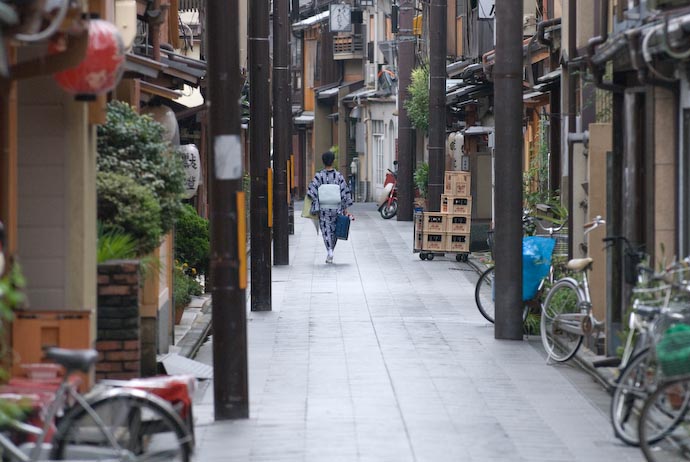
Nikon D200 + Nikkor 70-200mm f/2.8 @ 200mm — 1/800 sec, f/5, ISO 800, — map & image data — nearby photos
Kyoto's Miyagawa-Cho
early on a Thursday afternoon
It was raining off and on (mostly on) yesterday, but I accepted a kind invitation from Nils Ferry to visit his in-law's house in Kyoto's Miyagawa-cho district. It's the main center of Kyoto's geisha world, although lesser known than the nearby Gion nightlife area, which is both more famous and generally more picturesque.
(Gion has been featured a few times in my blog, with long-exposure cherry blossoms, and some regular night cherry blossoms, and a few pictures in one of the posts about my Aunt Jeannette.)
Gion is the area where they often work, but Miyagawa-cho is the main area where Kyoto's geiko (Kyoto dialect for “geisha”) and maiko (apprentice geiko) train and live their daily life, so you see them walking around all the time in various states of formalness. Many of the area businesses are related to the industry, and such, it's common to see normal women in kimono, just going about their day.
I'm not a big geisha gawker, but I do very much enjoy the sight of normal women in kimono just going about their day, such as the lady at the top of this post (or the one at the top of this post, or these ladies), so I quite enjoy the area. As Nils and I walked around the area, I saw many geiko and maiko, but found other things to take pictures of....
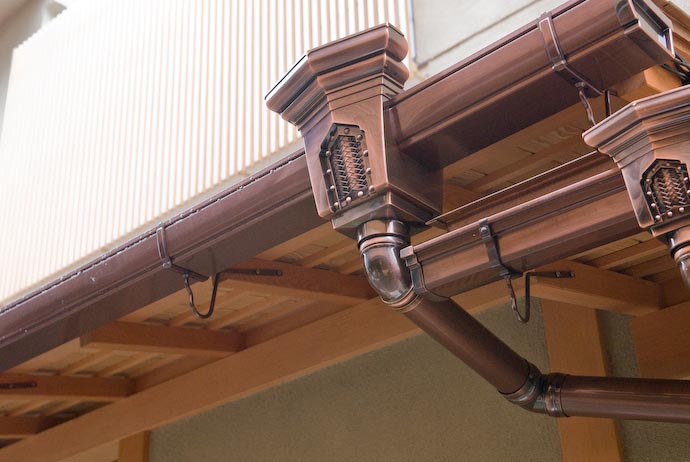
Nikon D200 + Nikkor 17-55 f/2.8 @ 35mm — 1/200 sec, f/5, ISO 800, — map & image data — nearby photos
Solid Copper Rain Gutter
Similar to the copper rain gutter in Kibune, the one on this recently remodeled house was clearly a work of art designed for both form and function. A wider view is shown below (it's the house on the near left).

Nikon D200 + Nikkor 17-55 f/2.8 @ 17mm — 1/320 sec, f/5, ISO 800, — map & image data — nearby photos
Quaint Little Street
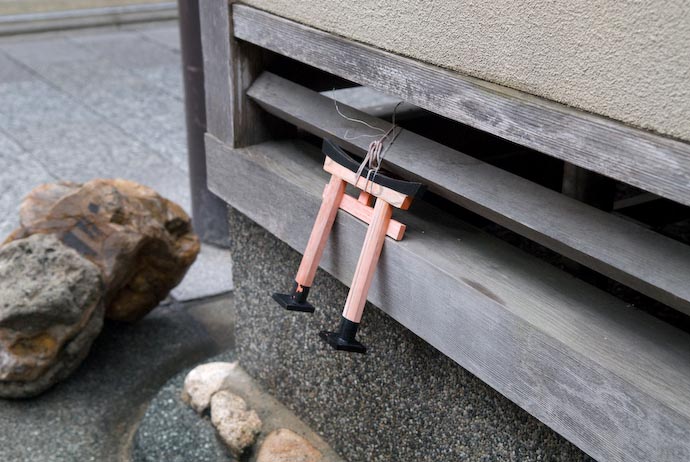
Nikon D200 + Nikkor 17-55 f/2.8 @ 35mm — 1/320 sec, f/5, ISO 800, — map & image data — nearby photos
“Do Not Pee Here”
Anywhere in Japan, a mini Shinto-shrine gate on a wall or fence has the same meaning as a sign saying “do not urinate here,” although one might guess the gate is more effective (the idea being that even someone who would pee against a wall in public would balk at doing so on a shrine).
For the record, I can say that they've been very effective in my case, in that I've never found the nerve to pee on one myself, nor on any wall within 8,000 miles of one.
Sadly, the area is not immune from modern eyesores...
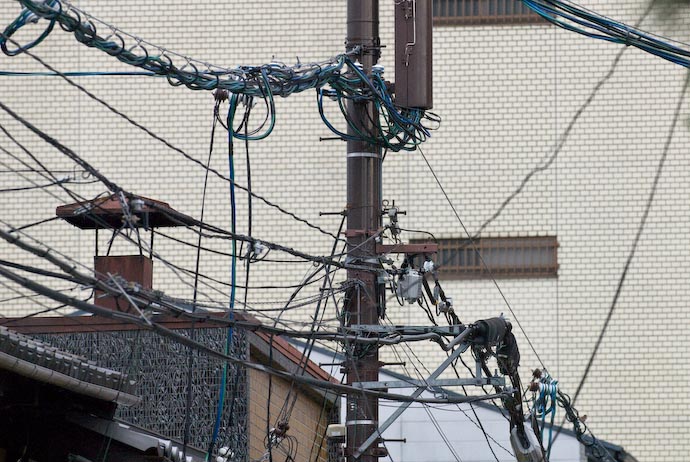
Nikon D200 + Nikkor 70-200mm f/2.8 @ 200mm — 1/1000 sec, f/6.3, ISO 1250, — map & image data — nearby photos
Modern Blight
Because that particular blight is common across Japan (including in front of my house), one simply tunes it out, but when looking with the eye of a photographer, you have to see them because the “tune out” does not happen when you see them in photographs. (Did you see the utility pole and wires in the picture above? Yes, I thought so. I rest my case 🙂 )
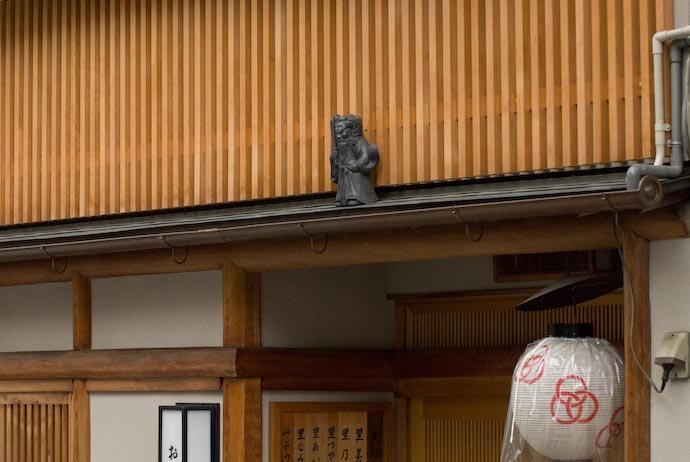
Nikon D200 + Nikkor 70-200mm f/2.8 @ 90mm — 1/320 sec, f/6.3, ISO 1250 — map & image data — nearby photos
Figurine Above the Entrance
to a Geiko/Maiko boarding house
The rain got a bit much, so we retired to the 160-year-old house of Nils' mother-in-law for tea and snacks, and to try to take pictures of the house's small but exquisite garden (maintained by an equally small and exquisitely refined mother-in-law). The weather was quite dark and gloomy by now, but I had my light-hungry Sigma 30mm f/1.4 lens with me, so by using that wide open and bracing the camera against something, I was able to come away with a few nice shots.
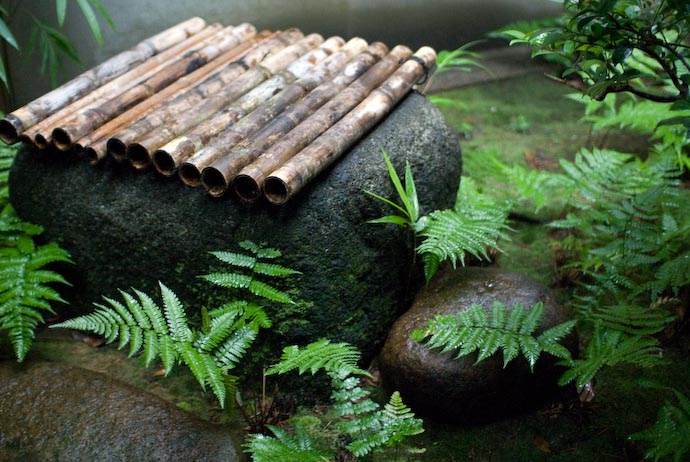
Nikon D200 + Sigma 30mm f/1.4 — 1/40 sec, f/1.4, ISO 1250 — map & image data — nearby photos
Well in a Private Garden
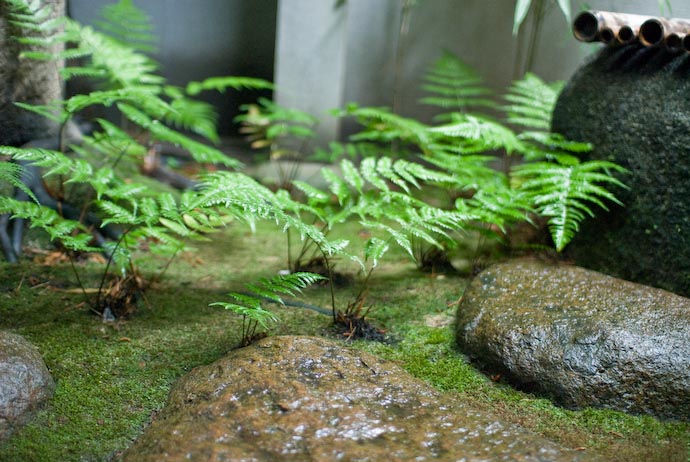
Nikon D200 + Sigma 30mm f/1.4 — 1/15 sec, f/1.4, ISO 1250 — map & image data — nearby photos
Moss, Ferns, and Rocks
Before leaving, we walked about a bit more, and I found myself doing a double-take when a rickshaw went by with two rickshaw drivers as passengers. Rickshaws are relatively rare in Japan (they're as much a novelty to Japanese as to foreigners), but living in the part of the city that I do, I see them every day. What I'd never seen were drivers in the passenger seat.
It turns out that the driver was in training, as evidenced by the “IN TRAINING” sign taped to the back...
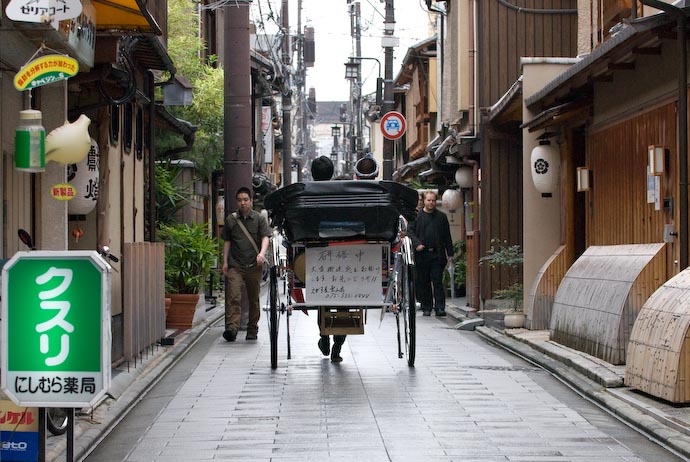
Nikon D200 + Nikkor 70-200mm f/2.8 @ 70mm — 1/350 sec, f/6.3, ISO 1250 — map & image data — nearby photos
Student Driver
I didn't realize it as I was snapping that shot, but the gentleman walking on the right (in all black) is the rather famous Peter MacIntosh, leading one of his geisha walking lectures. Peter is a Canadian who has apparently earned unprecedented acceptance into the inner workings of the geisha industry. It's not my cup of tea, but I'm able to appreciate the accomplishment, because it's easy to count the number of other foreigners who have ever done it: zero.
At the far left of that picture is a green sign for a drug store. Note the mobile display above it, for a drink that claims to break down fat. The mobile has a blow-up can and a blow-up stomach. How appetizing.
On a sad note, just after I left for the evening, Nils got called away to the hospital because his little Greg (with whom Anthony was playing just the other day) broke his arm while running around the house. Frankly, the way little boys tear around, it's amazing that any of them have a solid bone remaining, but I guess it's more a matter of luck than anything else if and when one breaks. Get well soon, little man!
Hello! I’m a Japan/geisha enthusiast from Malaysia and I’d just like to point out this slight inaccuracy (or possibly poor phrasing)-
“Gion is the area where they often work, but Miyagawa-cho is the main area where Kyoto’s geiko (Kyoto dialect for “geisha”) and maiko (apprentice geiko) train and live their daily life, so you see them walking around all the time in various states of formalness. Many of the area businesses are related to the industry, and such, it’s common to see normal women in kimono, just going about their day.”
There are actually five “hanamachi” (geiko districts) in Kyoto- Gion Kobu, Pontocho, Kamishichiken, Miyagawa-cho, and Gion Higashi. Each district has their own community of geiko and maiko, with a theatre and performing arts school, as well as teahouses and other traditional establishments where they entertain. A geiko can, and often does, get called to entertain at an establishment in district other than the one she lives in on occasion, but generally she lives, trains and works in the district she is affiliated with.
Nevertheless, this is a really interesting post with some lovely photos, and I’m quite pleased to see that this blog is still going strong after so many years (I did note that this post is almost ten years old). Keep up the good work!